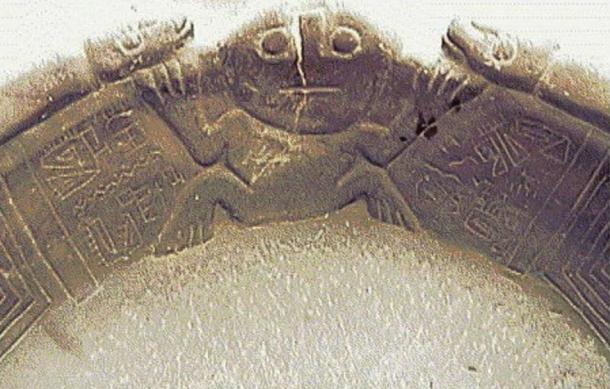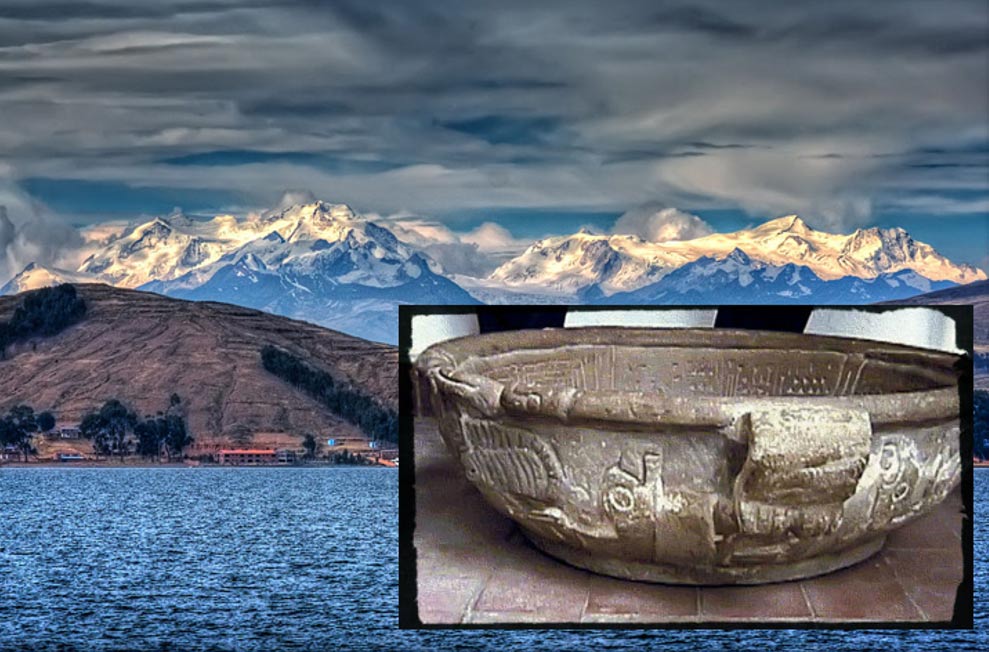Fuente Magna, the Controversial Rosetta Stone of the Americas
By April Holloway | The Epoch Times
The Fuenta Magna is a large stone vessel, resembling a libation bowl, that was found in 1958 near Lake Titicaca in Bolivia. It features beautifully engraved anthropomorphic characters, zoological motifs characteristic of the local culture, and, more surprisingly, two types of scripts —a proto-Sumerian ancient alphabet and a local language of the ancient Pukara, forerunner of the Tiahuanaco civilization. Often referred to as “the Rosetta Stone of the Americas,” the stone vessel is one of the most controversial artifacts in South America as it raises questions about whether there may have been a connection between the Sumerians and the ancient inhabitants of the Andes, located thousands of miles away.

The Fuente Magna Bowl was found near the world-renowned Titicaca Lake in Bolivia. (Wikimedia Commons)
The ancient relic was discovered accidentally by a farmer working on a private estate owned by the Manjon family. The owners subsequently delivered it to the city hall of La Paz in 1960 in return for land near the capital. Around the same time, Bolivian archaeologist Max Portugal Zamora learned of its existence and attempted, unsuccessfully, to decipher the unusual inscriptions, not least because he failed to recognize that the writing upon the bowl was a type of cuneiform text dating back some 5,000 years.
The Fuente Magna bowl remained in storage in the Museo de los Metales Preciosos (“Museum of Precious Metals”) for approximately 40 years, until two Bolivian researchers, Argentine Bernardo Biados and archaeologist Freddy Arce, sought to investigate the origins of the mysterious relic. They were eventually put in contact with Maximiliano, a 92-year-old local who, after seeing a picture of the bowl, claimed it was once in his possession. Not realizing its significance, Maximiliano admitted that he had used the bowl to feed his pigs.

The Fuente Magna Bowl was found to have two types of scripts engraved on the inside. (Courtesy of Bernardo Biados’s research team)
The two researchers took detailed photographs of the bowl and sent them to epigraphist Dr. Clyde Ahmed Winters, in the hope that he may be able to decipher the inscriptions. Dr. Winters, an ancient languages expert, compared the inscriptions to Libyco-Berber writing used in the Sahara approximately 5,000 years ago. The writing was used by the Proto-Dravidians (of the Indus Valley), Proto-Mande , Proto-Elamites, and Proto-Sumerians. Dr. Winters, in his article “Decipherment of the Cuneiform Writing on the Fuente Magna Bowl,” concluded that the writing on the bowl “was probably Proto-Sumerian,” and offered the following translation:
Approach in the future (one) endowed with great protection the Great Nia. [The Divine One Nia(sh) to] establish purity, establish gladness, establish character. (This favorable oracle of the people to establish purity and to establish character [for all who seek it]). [Use this talisman (the Fuente bowl)] To sprout [oh] diviner the unique advice [at] the temple. The righteous shrine, anoint (this) shrine, anoint (this) shrine; The leader takes an oath [to] establish purity, a favorable oracle (and to) establish character. [Oh leader of the cult,] open up a unique light [for all], [who] wish for a noble life.
This translations suggests that the Fuente Magna bowl may have been used to make libations to the Goddess Nia to request fertility. The figure on the Fuente Magna, which appears to be in a “Goddess pose,” with open arms and legs spread, is believed to support Dr Winters’ translation.

A figure on the Fuente Magna bowl. (Courtesy of Bernardo Biados’s research team)
If Dr. Winters’ translation is correct, this has major implications for our understanding of both Sumerian civilization and the ancient culture of Bolivia. Researcher Yuri Leveratto aptly poses the question: “How is it possible that proto-Sumerian inscriptions were found in a bowl that has been found near the Titicaca Lake, 3,800 meters [2.3 miles] above sea level, thousands of kilometers far away from the area where the Sumerian people used to live?”
According to Bernardo Biados, the Fuente Magna was most likely crafted by Sumerian people who settled in Bolivia sometime after 2,500 B.C. According to Biados, the Sumerians were known to sail to the distant Indian subcontinent and some Sumerian ships may have made their way around South Africa and entered one of the currents in the area that lead across the Atlantic from Africa to South America. It is possible that some chose to stay and explore into the Andes, perhaps searching for areas high on the plateau of Bolivia where food was being produced. Yuri Leveratto says, “the Sumerian culture influenced the people of the plateau, not only from a religious point of view, but also in the language. In fact, some linguists have found many similarities between the proto-Sumerian and Aymara languages.”
However, this perspective, and indeed the initial translation work of Dr. Winters has not been without its critics. Jason Colavito, a known skeptic and “debunker,” suggests that there is only a small degree of correlation between the script on the bowl and Proto-Sumerian characters. Colavito points out that the bowl has a highly problematic provenance, and may simply be a hoax. Biados says this is incorrect, citing the overwhelming support from major portions of the academic community.
It is clear that the Fuente Magna bowl remains a matter of contention between academics. It is hoped that further archaeological and linguistic research may help to unravel the story behind this mysterious artifact, as doing so may help to expand our understanding of the great civilizations of our past and their influence throughout the world.
Featured image: Fuenta Magna (Courtesy of Bernardo Biados's research team) Background: Lake Titicaca in Boliva (Wikimedia Commons).
The article ‘Fuente Magna, the Controversial Rosetta Stone of the Americas’ was originally published on The Epoch Times and has been republished with permission.




















Comments
“The writing was used by the Proto-Dravidians (of the Indus Valley), Proto-Mande , Proto-Elamites, and Proto-Sumerians.”
Then isn’t it obvious that that form of writing existed BROADLY - PRIOR to the emergence of the aforementioned cultures? So what really happened?
Nobody gets paid to tell the truth.
They are not Sumerians, they are Andites. According to the Urantia Book, they made their way to South America by island hopping over the Pacific Islands from Japan.
contradictory other equality : among the Maya ' Ix ' is used before a noun to denote the feminine, example : Ixchel , the goddess of the moon , is also set before the trades made by women, we all know the words of the genesis of the Bible: "and Adam said , This is now bone of my bones and flesh of my flesh: she shall be called woman ( ' Ishshah ) because of the Man ( ' Ish ) was taken . " a curious case of inversion of letters is : Ha ( Hebrew) before a word indicates ( the ) example ha- adamá (the land ) in Maya Ah ( Lord ) , placed before the name denotes masculinity ( Ahpu ),reverse cases
Some time ago I investigated on these contacts and this is part of what I found and that is proof the vicinity of these cultures , in this case with the Maya : 1.The Mayan calendar and the Hebrew alphabet , the first letter of the Hebrew is aleph = alpha ( Greek) , it is written similar to the symbol (% ) in reverse , which is equal to Ahpu ( 20th and last of the Mayan calendar ) (alpha) whose symbol is accurate to alpha ; 2.Omega the last Greek letter (alpha and omega ) , but in this case in the Mayan calendar is reversed to the first position with the name of Imox or Imix ; ... Greek → alpha- omega .. Mayan → Imox -ahpu ; two similar worlds and are expressed in inverted form .
The philologist Cyrus Gordon wrote several books about ancient Near Eastern voyages to the Americas. Although his books didn't cover this bowl, they did discuss other writings found in South and North America that remained in dispute for a very long time.
But recent discoveries in ancient literature have verified their authenticity, as Gordon showed in Riddles in History. Many of the ancient writings had ancient riddles buried inside the text, and when they re-examined the disputed texts founds in the Americas, they found these too had the hidden riddles no forger could have known about 100 years ago.
I wonder if these text has a hidden riddle, such as the author's religion and devotion?
Tom Carberry
Pages